Overview
This feature allows you to provide your product information to third parties like e-commerce platforms, mobile applications, suppliers... or, more simply, if you want to extract information from the PIM for your usage.
You have several ways to export your product information:
- You can manually download the export file: execute the job from the PIM user interface, and download the generated file.
- You automatically send the export file to the third-party, by setting a path in the export profile configuration enabling the PIM to drop the file when executing the command automatically.
When exporting data, Akeneo PIM extracts data from the PIM and converts it into a specific format to a file or directly to a third-party application (e.g., Magento).
The exports can be done in two formats: CSV and XSLX.
You can export product data and catalog entities such as families, categories, and attributes.
Steps of an export
The file export process is straightforward. It consists in:
- Creating an export profile (see below for more information)
- Launching a CSV or XLSX file export
What is an export profile?
An export profile allows performing exports from the PIM. This profile format is based on the following:
- A code to identify the export profile
- A job to define what will do the export when executing. For instance, a category export in an XLSX file or a product export in CSV destinated to a Magento platform
- A set of configuration fields, available as a form in the PIM. Each export profile can have its configuration.
Browse your export profiles
To view the available export profiles:
- Log in with a user account with permission to View the list of profiles for exports
- Go to the Exports menu
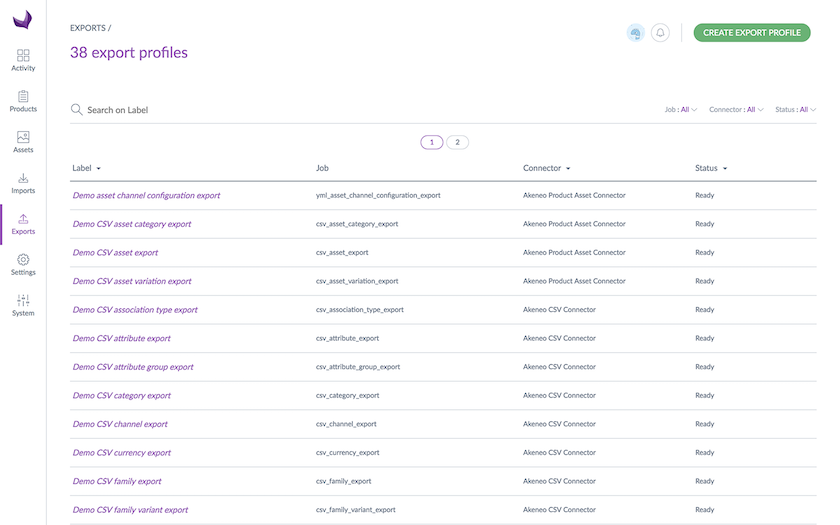
- To narrow down the list of displayed export profiles, use the available filters above the grid or the search bar that will search on the label
To see the information of an export profile, click on the row in the grid
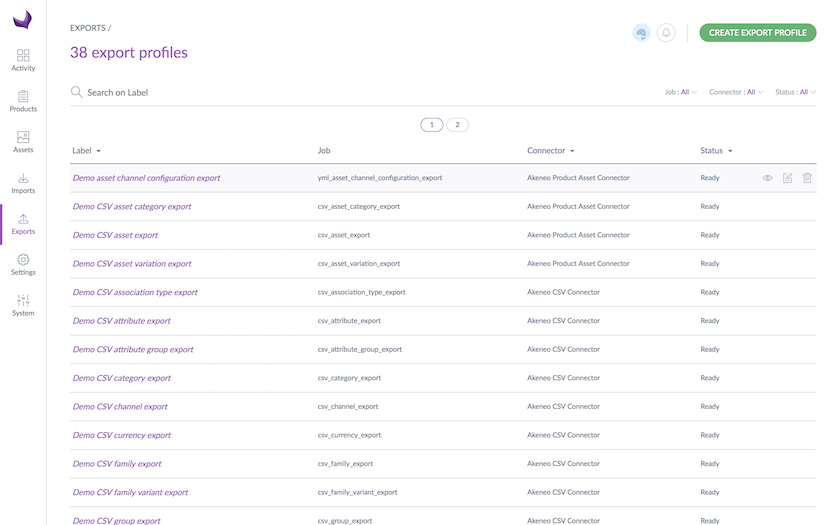
Create a new export profile
To create a new export profile:
- Log in with a user account with Create an export profile permissions
- Go to the Exports menu
- Click on Create export profile
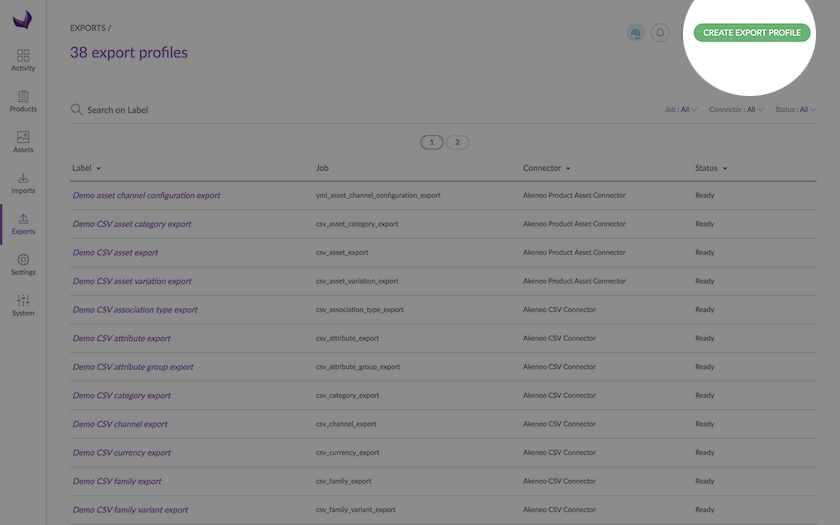
- All fields in the pop-up window must be filled in:
- A unique code
- A name to identify the profile more easily
- A job according to what you wish to export
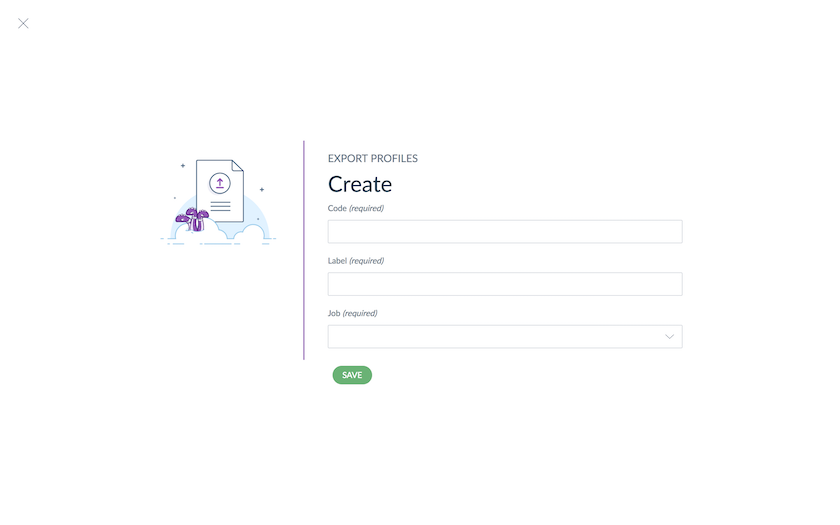
- Click on Save to finalize the export profile creation. The profile page screen is displayed. You can then configure it.
Update an export profile
To update an export profile:
- Connect with a user account
- Go to the Exports menu
- Click on the export profile that needs to be modified
- Click on the Edit button
- Make your changes
- Click on Save to update the profile
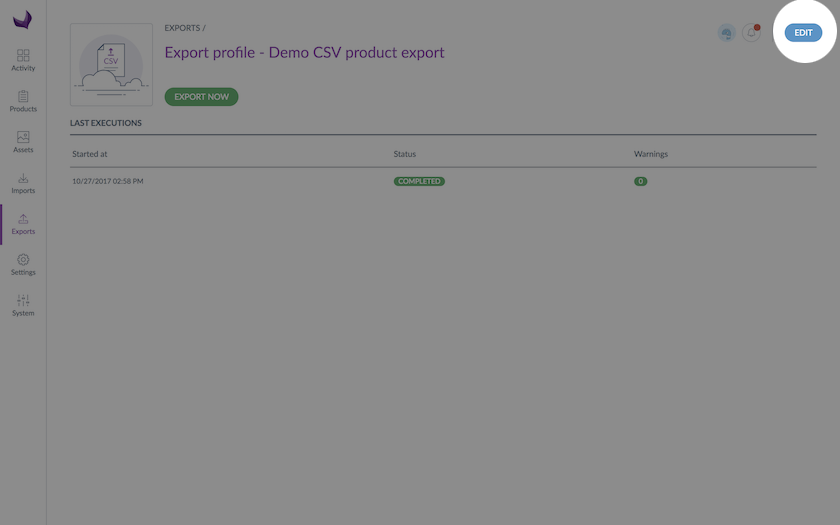
In the tab General properties, you can edit the label of your profile.
In the Global settings tab, properties depend on the export job. For example, for the XLSX product export, you will find the following properties:

| Property | Details |
| File path | Defines where to export the generated file (not available in Serenity offer) |
| Decimal separator | Defines the character used as a decimal separator in the exported file |
| Date format | Defines the format used for dates in the exported file |
| Measurement format | Defines the format used for measurements in the exported file, whether the code/label or the symbol is exported |
| Delimiter | Defines the character to delimit the fields in the CSV file |
| Enclosure | Defines the character for the field enclosure in the CSV file |
| Number of lines per file | Defines the maximum number of rows per file for XSLX export |
| With header | Defines if the first line of the exported file contains the columns' names |
| Export media | All media (from asset collection, image, and file attributes) of the products will be exported if activated. You'll get an archive with the CSV file and a folder with the media |
| Export with labels | Defines if the export file displays values' labels instead of values' codes |
| Headers with labels* | Defines if the export file displays headers' labels instead of headers' codes |
| File locale* | Defines the locale in which labels are displayed |
| With product UUID | Adds the product UUID in the file as the first column |
| With product completeness | Adds the product completeness ratio for all exported locales |
*Only visible if the option Export with labels has been activated.
If you export a file with labels and not codes, you won't be able to re-upload it in the PIM afterward.
If the asset collection attributes of your products are linked to asset families with a media link attribute used as main media, when you export the products, you won't get an archive. You will only export a CSV or an XLSX file with a column containing the URL of the media.
In the case of products and published products exports, you will see an additional tab called Content. In this tab, you can precisely define which products or published products' data you want to export. To learn more about this product export builder feature, look at this article about Product Export Builder.
If a user has no rights granted to modify an export profile due to his role, then the permissions he may benefit from due to his user group(s) (EE only) will not be applied. For instance, if a user does not have the Edit profiles of exports permission, his Enterprise Edition rights to edit a specific export profile are ignored.
Duplicate an export profile
If you want to create another export profile based on an existing one, you can duplicate it. To do this, please follow the steps below:
- Select the export profile you would like to duplicate
- Click on Edit
- In the top right corner, click on the three dots "..." and select Duplicate
- Write a label and a code then click on Save
Download and upload an export profile
To copy an export profile from one instance to another (e.g., from a staging instance to a production instance), you can download the existing profile’s configuration and import it into a new profile on the other instance.
Download an Export Profile Configuration
- Select the export profile you want to copy.
- Click on Edit.
- In the top right corner, click on the three dots (”…”) and select Download Profile Configuration.
Upload the Profile Configuration to Another Instance
- Create a new profile in the other instance.
- Click on Edit.
- In the top right corner, click on the three dots (”…”) and select Import Profile Configuration.
- Upload the configuration file you downloaded earlier.
This functionality is available with:
- Tailored export
- Product export
- Product model export
Please note that permissions and properties are not included in the configuration you download and import.
Run an export
- Go to the Exports menu to see the list of available export profiles
- Select the export profile to execute, and click on the relevant line
- The export profile page is displayed. Click on the Export now button
- The page of the export execution is prompted. The page refreshes continually to let know at what stage the export is
When the export ends, a notification is available on the top right corner of the PIM.
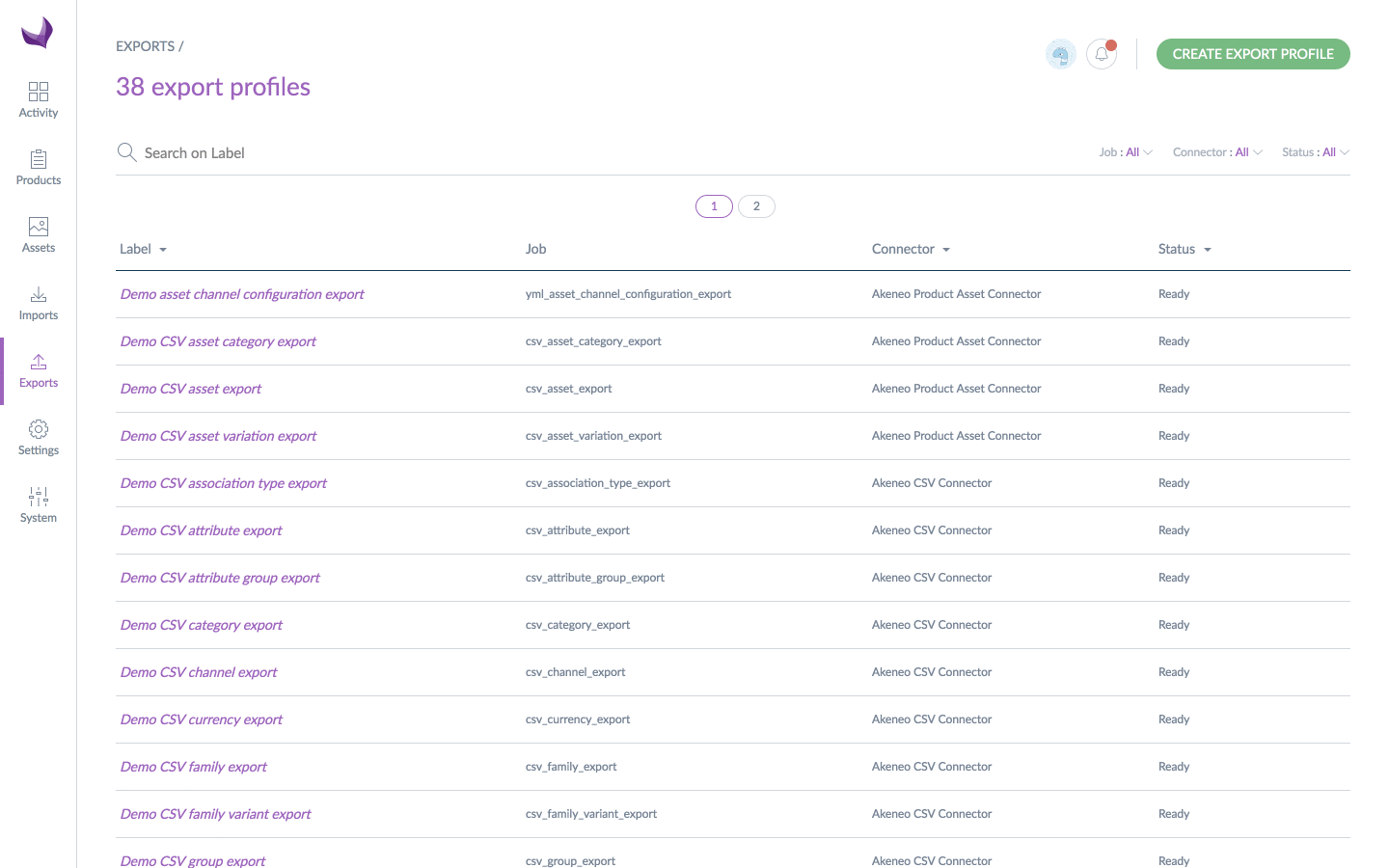
An email can also be sent depending on your user configuration. For further details on this, please refer to the Manage your account article.
Please note that by default, your exported files will always contain the following columns:
- Main identifier
- Categories
- Enabled
- Family
- Parent (if applicable)
- Groups
- Association types
- Created
- Updated
If you want only to export the data you need, please consider using Tailored Export profiles.
With the user groups rights (EE only)
Rights on the product information
In the case of product and published product exports, the PIM takes into account your permissions based on the user groups you are in:
- you do not have a view right on the products that are in the Goodies category; you won't be able to export any information about these products
- you do not have a view right on the Marketing attribute group; you won't be able to export the product information of the attributes in this attribute group
- you do not have a view right on the de_DE locale; you won't be able to export any product data regarding this locale
To know more about how the rights on product data work in the PIM, look at the Access rights on products article.
Rights on export execution
The permission to execute exports can be customized for each export profile. So if you cannot launch an export, be sure that you have the right to run it in the Permissions tab of your export profile in edition mode. See the Access rights on imports/exports article for more details.


